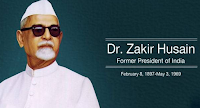Zakir Husain Khan (The Third President
of India) Biography
జాకీర్ హుస్సేన్ ఖాన్ జీవిత చరిత్ర
Zakir Husain Khan (8 February 1897 – 3
May 1969) was the third President of India, from 13 May 1967 until his death on
3 May 1969.
He previously served as Governor of
Bihar from 1957 to 1962 and as Vice President of India from 1962 to 1967. He
was also the co-founder of Jamia Milia Islamia, serving as its Vice Chancellor
from 1928. Under Husain, Jamia became closely associated with the Indian
freedom movement. He was awarded the Bharat Ratna, India's highest civilian
honour, in 1963.
Family and Early life
Husain was born in Hyderabad, Telangana,
into a Pashtun family of the Afridi tribe. After Husain was born, his family
migrated from Hyderabad to Kaimganj, where he grew up. He was the second of
seven sons, Husain's family would remain active in public life: his grandson
Salman Khurshid, a Congress politician, is the former Foreign Minister of
India, and his nephew was the noted academic Masud Husain.
Husain's father, Fida Husain Khan, died when he was ten years old; his mother died in 1911 when he was fourteen. Husain's early primary education was completed in Hyderabad, He completed High school from Islamia High School, Etawah, and was then educated at the Muhammadan Anglo-Oriental College, then affiliated with the University of Allahabad, where he was a prominent student leader.He received his doctorate in economics from the University of Berlin in 1926.In 1915, at the age of 18, he married Shah Jahan Begum and had two daughters, Sayeeda Khan and Safia Rahman.
Career
When Hussain was 23 years old, with a
group of students and teachers he founded the National Muslim University, first
founded in Aligarh on Friday 29 October 1920 then shifted to Karol Bagh, New
Delhi in 1925, then later shifted again on 1 March 1935 to Jamia Nagar, New
Delhi and named it Jamia Millia Islamia (a central university). He subsequently
went to Germany to obtain a PhD from the Frederick William University of Berlin
in Economics. While in Germany, Husain was instrumental in bringing out the
anthology of arguably the greatest Urdu poet Mirza Assadullah Khan
"Ghalib" (1797–1868).
He returned to India to head the Jamia
Millia Islamia which was facing closure in 1927. He continued in that position
for the next twenty-one years providing academic and managerial leadership to
an institution that was intimately involved with India's struggle for freedom
from the British Rule and experimented with value-based education on the lines
advocated by Mahatma Gandhi and Hakim Ajmal Khan. During this period he
continued to engage himself with movements for educational reforms in India and
was particularly active in the affairs of his old alma mater the Muhammadan
Anglo Oriental College (now the Aligarh Muslim University). During this period
Hussain emerged as one of the most prominent educational thinkers and
practitioners of modern India. His personal sacrifice and untiring efforts to
keep the Jamia afloat in very adverse circumstances won him appreciation of
even his arch political rivals like Mohammed Ali Jinnah.
Soon after India attained independence,
Husain agreed to be the Vice chancellor of the Aligarh Muslim University which
was facing trying times in post partition India because of active involvement
of a section of its teachers and students in the movement for creation of
Pakistan. Husain, again, provided leadership during a critical phase of the
history of the University at Aligarh from 1948–1956. Soon after completing his
term as Vice Chancellor, he was nominated as a member of the Upper House of
Indian Parliament in 1956, a position he vacated in 1957 to become Governor of
the State of Bihar.
After serving as the Governor of Bihar
from 1957 to 1962, and as the second Vice President of India from 1962 to 1967,
Husain was elected President of India on 13 May 1967. In his inaugural speech,
he said that the whole of India was his home and all its people were his
family.
Death
Husain died on 3 May 1969, the first Indian President to die in office. He is buried along with his wife (who died some years later) on the campus of Jamia Millia Islamia in New Delhi with the main objective of providing facility for higher education in Ilayangudi, a college was started in his honour in 1970.The Engineering College of Aligarh Muslim University is named after him.


0 Komentar